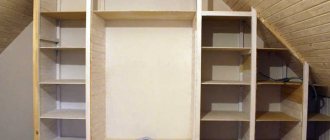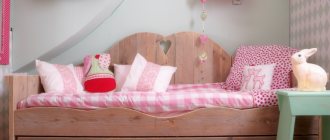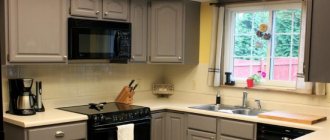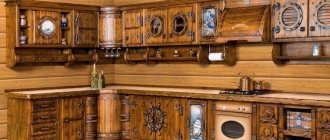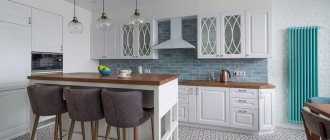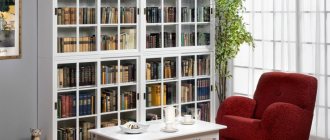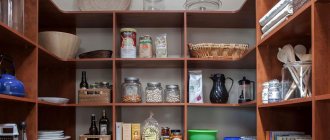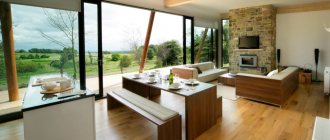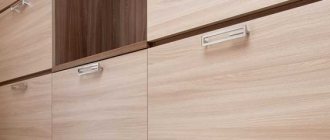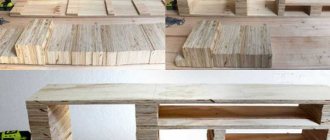A kitchen sideboard is more than just a beautiful piece of furniture with specific functions. A special feature of the buffet is, firstly, the symbolism of this kitchen item. After all, this is not only a convenient closet with spacious drawers, it is an integral component of home warmth and comfort.
Secondly, the buffet is not subject to time and the transience of modern trends in the field of interior and home design. This magic cabinet is unique in that it has not lost its relevance and popularity over many centuries.
The kitchen cupboard is not only beautiful, but also functional.
The next feature is the versatility of functions, which include the following factors.
- Domestic. Housewives are happy to store many different-sized kitchen utensils.
- Interior. Modern designers skillfully integrate this item into any kitchen design.
What is a kitchen buffet?
When choosing a buffet for the kitchen, it is important to understand what exactly we are talking about and not to confuse a buffet, for example, with a pencil case or cabinet. So, a kitchen cupboard is a separate piece of furniture that is designed for convenient storage of items such as kitchen utensils, kitchen appliances, cutlery, dishes, etc.
A sideboard is fundamentally different from a cabinet or pencil case.
IMPORTANT! The sideboard is similar to the pencil case in height, but superior in width. In most cases, the buffet has an additional tabletop located in a niche.
TOP 7 styles in which a solid wood buffet looks great
- Classic style . A sideboard made in this direction should be of a noble color, for example, brown, beige, etc. In the classic style there should be no unnecessary details or clutter, so you should not use too many decorative elements.
- Art Nouveau assumes the presence of light furniture in pastel colors, decorated with carvings, ornaments and ornate patterns. The presence of plant compositions, smooth lines and semicircular shapes is also welcome here.
- Country , which can also be called rustic style. The interior, designed in this direction, is particularly cozy and warm. The sideboard must certainly be made of solid wood.
- Provence . In French village houses, antique furniture and beautiful sideboards are often used. If the goal is to create a light French atmosphere, then you should choose a cabinet close to those found in the houses of Provence, the southern region of France.
- Retro . It can be either an antique solid wood sideboard or a modern one, but artificially aged. If you want to make the cabinet more authentic, you can use the decoupage technique, painting it in light shades with the addition of patina.
- The buffet, made in Scandinavian style , has a white color traditional for this trend. The laconic design can be complemented with chrome fittings. For production, not only solid wood is used, but also plastic, glass, acrylic and other modern materials.
- Loft . The cabinet made in this direction has a slightly rough modern design. In this case, both wood and metal can be used as materials.
Time passes and a lot changes, but the classics are always popular. Antique things that have served their owner for decades have been and will continue to be valued.
A classic solid wood buffet will become an undoubted decoration of the living room. Most often, dark wood species are used to make this piece of furniture.
A classic buffet can consist of two sections. The first is open shelves protected by glass with impact-resistant properties. As a rule, they place the most valuable and beautiful things that you want to show to guests. These can be prizes, antique dishes, handmade items, and much more.
The lower section is most often closed. It is usually used for storing equipment, documents, etc.
The main feature of such furniture is the light color, but there is also durable dark wood, which contrasts well with floral wallpaper and soft fabrics. Light shades themselves are light and cute.
A solid wood sideboard made in this direction is a cabinet made from modern materials with an antique effect and stained glass doors. Decoupage, patina, images of flowers and carvings are often used in decoration.
Types of kitchen buffets
- Classical. Designed to store not only dishes, but also groceries. It is acceptable to use it as a place for preparing light dishes and drinks, or for decorating products before serving.
- Sideboard. The most popular antique version of the last century, has glass doors and display cases, and no countertop.
- Buffet showcase. Equipped with deep shelves, usually without doors, which allows you to quickly and freely remove stored items and products.
Shape and dimensions
The standard shape of a kitchen buffet is rectangular. But a professional designer will be able to bring to life unusual shapes of the product. The classic sizes are considered to be:
- width from 120 to 200 cm;
- height from 180 to 200 cm;
- depth from 40 to 60 cm.
Buffets may vary in shape and size.
ADVICE. Do not be upset if the kitchen does not allow you to accommodate a cabinet with such dimensions. An individual project for a kitchen set with a buffet should be ordered from the manufacturer, taking into account your “metric” capabilities.
Instructions for making a corner sideboard
The corner of the room is often left empty. If there is a shortage of usable space in the kitchen or living room, a corner cabinet will provide greater freedom.
Prepare your tools. In principle, the list is the same as described in the previous case, only we don’t need clamps.
Select the following materials:
- boards 290 mm wide and 12 mm thick;
- plywood 8 mm thick;
- dowels - wooden dowels;
- wood glue;
- stain;
- furniture or water-soluble varnish;
- self-tapping screws;
- furniture handles and hinges;
- ruler, tape measure, pencil or marker;
- sandpaper.
Specification
All parts are marked in the pictures with numbers in red circles:
- Back wall 1 pc. – (No. 1) 183 cm.
- Trapezoidal shelves 6 pcs. – (No. 2) 77.5 cm in front. The sides are cut at an angle of 45° from the straight sides (see picture)
- Front side strap 2 pcs. – (No. 3) 183 cm.
- Side walls made of plywood 2 pcs. – (No. 4) 41.3 cm x 183 cm.
- Upper and lower cornice 2 pcs. – (No. 5) 67 cm.
- Table top cornice 1 pc. – (No. 6) 67 cm.
- Top molding 1 pc. – 90 cm.
Pass boards 1830 mm long through a surface planer. Mark and cut 2 boards with a circular saw into six trapezoidal shelves. The shelves will have a small base with a width of 1950 mm and a wide side of 775 mm.
Using a circular saw, cut one board into two 60 mm wide slats; from the other slats, make a web for the back wall with a transverse dimension of 195 mm (according to the width of the small shelf base).
Attach six horizontal segments (top cover + bottom base + 4 shelves) to the back wall with self-tapping screws.
On the front side of the case, attach two vertical strips - supports - with self-tapping screws. Embed the self-tapping screws into solid wood so that you can putty the fastener sockets later. Mount the lower base at a distance of 70 mm from the floor. Place the shelves at equal distances from each other. It is important that the third shelf from the bottom, which will be the tabletop, is fixed at a distance of 760 mm from the floor.
To make the side walls, cut 2 boards from plywood according to the height of the cabinet (1830 mm). Attach the walls with self-tapping screws and glue to the bases and shelves of the case.
Prepare three cornices. Make a curly cutout in the bottom bar, as in the picture. Process the middle and upper cornice with a router - make curly grooves and notches.
You can secure the cornices with wood glue; be sure to secure the lower support bar with self-tapping screws.
Making doors
Assemble two transoms from 45 mm wide planks (the length is indicated in the figure). Do this using tongue-and-groove corner joints and coat them with wood glue. On the back side of the transoms we screw the plywood sheets with screws.
You should have two doors with a height from the middle of the bottom bar to the middle of the middle cornice (635 mm). The width will be equal to the distance from the middle of the side vertical bar to the central axis of the body (335 mm).
Treat hard-to-reach areas of the body with a grinder or a block of sandpaper. Paint all surfaces with stain. Then coat with furniture or water-based varnish. If you are skilled in craquelure, you can give furniture a noble, aged look in the form of a patina.
Using a chisel or a router, cut out the seats for the hinges in the sides and doors. Hang the doors by screwing the hinges with screws. Drill two holes in the vertical slats of the transoms in the center and screw two handles.
Install a central vertical stop bar inside the cabinet. The doors will rest against it and will not fall inside the cabinet.
Put the corner sideboard in its place. You can glaze the upper compartments for dishes by installing horizontal guides for sliding glass panels.
Design features of the buffet
The structure of the buffet can be divided into the following elements:
- upper section;
- middle section;
- lower section
The buffet can be roughly divided into three parts.
Upper section of the cupboard
In the upper section it is convenient to place those utensils or dishes that are not intended for daily use. For example, crystal wine glasses for a festive table or tablecloths for receiving guests.
For convenience, the upper section is not equipped with doors, leaving the space open. But, on the other hand, the presence of glazing will protect the dishes from unwanted dust and other contaminants that are often found in the kitchen.
The upper section of the buffet can be either open or glazed.
Middle section
The middle section consists of several drawers with a sliding mechanism. They contain cutlery, napkins, small towels and other small items that should be at hand. An important component of the middle section is the tabletop.
The middle section contains drawers and a table top.
TIP: the optimal solution for a small kitchen is a retractable countertop.
Buffet base
The main part of the buffet will be large cabinets with shelves, which are closed with wooden front doors. As a rule, housewives store heavy dishes (pans, pots, household appliances) there.
Large tableware and household appliances are stored at the base of the buffet.
Buffet in history
The first mentions of buffets date back to the 15th century. Such furniture appeared in the homes of wealthy French nobility and was intended for storing expensive tableware. Then the cabinets were double-leaf, where one section was reserved for porcelain and the other for silverware.
Over time, by the 17th century, furniture acquired modern shape. The design was divided into 3 sections along the horizon and a table top with a display part for dishes appeared in it. The bottom cabinet changed from a two-section to a multi-section, but each door still locked.
The sideboard can be considered the ancestor of all complex kitchen furniture.
The time of the appearance of sideboards in Russia, after the German purge of history during the reign of Catherine, has not been established for certain, but it is known for sure that wooden cabinets with a cabinet and an upper superstructure were actively used in the country long before Europeans arrived here.
Types of frames and size range
The main criterion for classifying frames is their shape.
- Straight frames are a classic example. The advantage of this model is the ability to install anywhere, even in the living room, as well as ease of manufacture.
- Corner frames in the shape of the letter L are accordingly placed in the corner of the room, which helps to harmoniously place a corner kitchen buffet even in a small room.
- Radius frames are popular these days, as they allow you to brightly play with non-standard design solutions and give the kitchen individuality.
What wood are the buffets made from?
Buffets are made from different types of trees. Let's look at the main ones.
1. Pine.
This type of wood has a brown, beige-yellow or white color with small pink streaks. The ideal material for making sideboards and other furniture are pine trees, which grow on dry hills or hills with sandy soil. The annual layers of such wood are narrow, pronounced and located close to each other.
Pine, which grew in areas where there is high humidity, has a loose structure, and blanks made from it have to be dried for quite a long time before being used for furniture production. Solid pine is soft, so it is easily damaged and scratched.
The advantages of this tree:
- Easy to process. It is easiest to plan wood along the grain; it is more difficult to plan across it.
- Sticks well.
- Depending on the structure and color of the wood, it can be used both for making furniture with further varnishing, and for creating frames with different designs, which are then lined with hardwood veneer.
- It has a pleasant smell, characteristic of all coniferous trees, and also releases phytoncides that have medicinal properties.
2. Larch.
The value of this type of wood lies in the fact that it has high performance characteristics and an unusual reddish-brown color. As for the disadvantages of this tree, it is the release of a large amount of resin, which complicates the processing process and disables tools. If larch is not dried properly, cracks may appear inside it.
So, the advantages:
- high resistance to moisture;
- the best strength indicators among coniferous woods;
- practically does not warp;
- can be used to make carved elements.
3. Yew.
Facade and decor options
The exterior or front side of the buffet is called the front. Facades can be solid or block. Solid facades are considered more reliable; they are made from solid wood. This quality makes the façade easy to clean.
Frame facades benefit in price; they consist of a base and edging. The two components of a framed buffet are usually made of different materials, which allows you to play with one color or another in an interesting way.
What decor can be present on a kitchen buffet?
- Thread. This decoration element is ideal for a wooden surface.
- Engraving. It can also be applied to metal.
- Glazing. It is especially advantageous to use glazing on the top of the buffet. Moreover, it is not at all necessary to use transparent or translucent glass. Non-standard solutions are in fashion – colored mosaic designs.
- Veneering. This is the name given to the external treatment of MDF with a thin layer of solid wood. An excellent option that will allow you to save your budget and buy an inexpensive buffet.
Types of display cabinets for the living room
The living room is the center of the house, a gathering place for all family members and their guests for relaxation and special occasions. This is where people gather to talk, have a good time together, and have fun.
A well-organized living room space will create the necessary atmosphere of comfort, well-being and warmth. Tastefully selected display buffets with beautiful dishes will decorate the interior of the living room, give it noble solidity, and add charm.
There are several types of such cabinets, each of which has its own advantages:
- hanging - with a large number of shelves;
- corner - to save space;
- traditional floor.
- Hanging buffet display.
- Corner floor buffet display.
- Standard display buffet for the living room (photo below).
- Built-in buffet display.
In a small living room, a full glass display cabinet will take up a lot of space. Therefore, it is recommended to use hanging cabinets to store dishes and souvenirs. They will look especially appropriate in the style of minimalism or hi-tech. Corner wall cabinets have additional advantages. They can be mounted vertically or horizontally, in any order and at different levels. The design of the doors allows them to open in any desired direction, and the built-in lighting emphasizes the contents. Such cabinets have special fastenings for placement on walls and, due to their design, take up little space.
A very successful option, it significantly saves space due to the fact that it uses “dead” planning zones - corners. Placing it in a corner allows you to make the display buffet deeper, give it a fancy shape and use a larger area of the doors for glazing. This technique allows you to place more items inside the cabinet and provide them with a good view. Placing cabinets in this way makes a narrow living room visually wider and hides layout flaws.
Traditional wardrobe. It consists of two parts - the lower one, without glazing, and the upper one - with glass doors. It has several compartments and a sufficient number of shelves. Classic style display cabinets usually have legs. The presence of such an item in the interior of your living room, complete with other furniture accessories, makes it luxurious and cozy.
In modern interiors, the built-in version of a display buffet in the living room has become widespread due to the capabilities of modern finishing materials. Such models look especially advantageous in spacious rooms decorated in the same style.
Features of the internal filling and storage systems of the buffet
The internal equipment of any buffet should be based on the needs of the future owners. The following are considered standard elements.
- Shelves of various types. For low tiers, a closed option is more suitable, while open shelves are acceptable in the upper part.
- Boxes. Deep drawers are designed for large items, and small flat drawers will accommodate cutlery.
The internal filling of the buffet consists of various shelves and drawers.
Special attention should be paid to the doors. Modern buffet designs are replete with sliding doors or even folding options.
Classic swing doors are becoming less popular.
How to choose a kitchen cupboard for dishes
First, you need to choose the style of the product. Secondly, choose colors and decor. Thirdly, choose the functional content.
IMPORTANT! It is worth considering individual needs when choosing the size and type of boxes. Not all housewives need a variety of large drawers, and some cannot imagine a buffet without small, narrow, neat doors.
The style of the buffet is chosen based on personal preferences and the overall interior design.
DIY kitchen buffet
Making a kitchen buffet yourself is quite possible. For this you will need:
- Internet access (there you will find a lot of buffet options with different designs in a couple of minutes);
- tools;
- materials;
- desire and imagination to create an individual masterpiece.
You can make a simple buffet yourself.
Deciding on design and construction
Making your own kitchen cupboard opens up a wide field for the imagination of the home craftsman. He can make it, in accordance with his vision and ideas, in various styles:
- retro;
- high tech;
- art;
- minimalism and others.
Modern buffets for the kitchen can be made, guided by a step-by-step description of this process.
Cabinet designs can also be very diverse, including corner and round.
Styles of cupboards
First of all, you should take into account the overall design of the kitchen and select an option that will fit harmoniously into it. Main style directions.
- Classic. A buffet in this style is characterized by neutral colors and small decor in the form of carvings.
- Modern. In this case, light colors predominate, especially shades of Provence, smooth lines, ornate patterned designs are acceptable.
- Country. The most environmentally friendly option, minimal design, priority is solid wood.
- High tech. The most common style, which involves the presence of metal inserts and glossy elements. The lines are clear, right angles and regular shapes.
Where would a solid wood buffet look good?
1. Large kitchen.
The buffet cabinet is the centerpiece of the kitchen, so no matter where you place it, it will always make a statement.
However, if we talk about a spacious kitchen, then such furniture is usually placed not far from the dining table or opposite the front door.
2. Dining room.
In this case we also mean a fairly large room. The buffet here is also placed closer to the table.
3. Living room.
An oak or walnut buffet will perfectly complement the interior of a living room in a classic style. Namely:
- For a room decorated in this direction, it is necessary to select a wardrobe of the appropriate style, that is, classic, made of solid wood.
- You should choose a buffet according to the size of the room. If it is small, then you should give preference to miniature models and preferably made of light wood with a minimum number of decorative elements and patterns.
- If the area of the room is large, you can place one or even two plain buffets located close to each other.
4. Studio apartment.
In this case, as a rule, modern models are used for elegant zoning of space.
The most popular options include a buffet bar, the counter of which can be folding or stationary.
5. Kitchen in Khrushchev.
In small kitchens built during the Soviet era, you can also place a buffet.
If large models take up a lot of space, then a corner cabinet will be the best option in this case.
Rules of care
- Keep surfaces dry, promptly removing any spilled liquid from both the façade and internal elements.
- Ensure the cleanliness of fasteners and remove dirt immediately. This will allow the buffet to function properly for many years to come.
- Do not use aggressive chemical solutions for cleaning. Firstly, they are extremely toxic and can be harmful to health. Secondly, they can damage the front part of the furniture.
Caring for the buffet is simple and involves proper cleaning.
